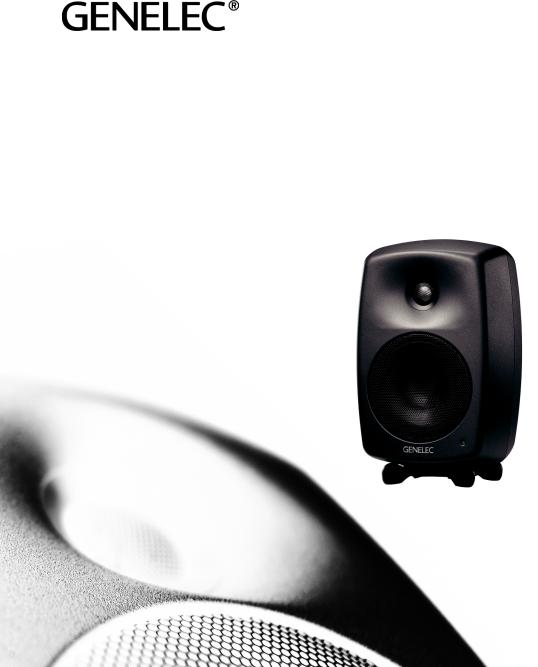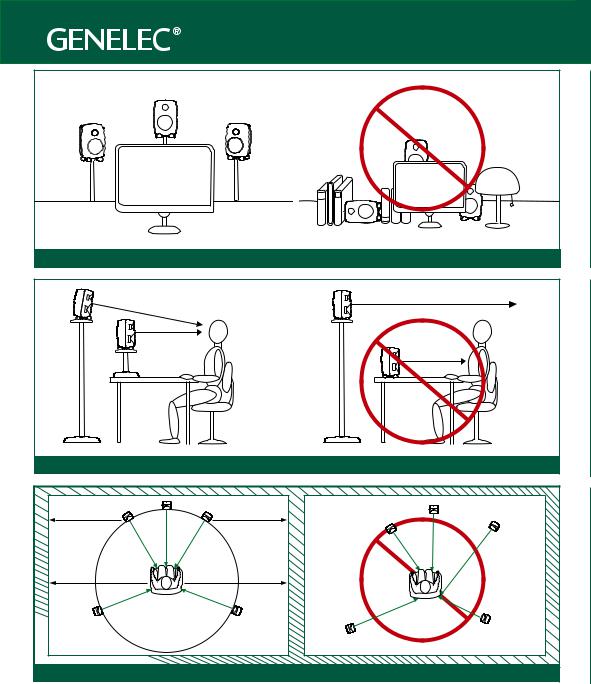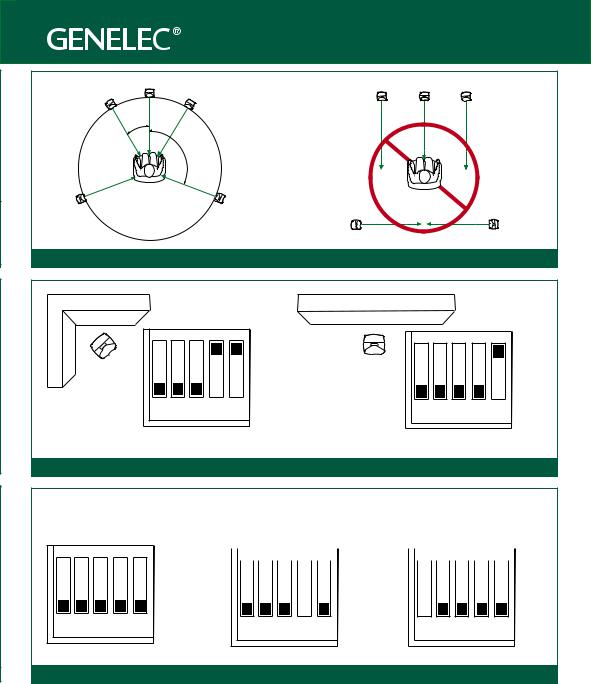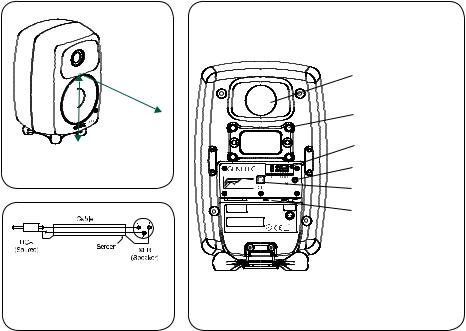Genelec 8030C User Manual

8030C
Quick Setup Guide 2-3
Operating Manual 4-9
Käyttöohje 10-15

Quick setup guide 8030
Speaker Placement
Vertical Angle
A |
L |
C |
R |
A |
|
C |
|
|
|||||
|
|
|
L |
R |
||
|
|
|
|
|
||
B |
|
|
|
B |
|
|
LS |
|
|
|
RS |
|
RS |
|
|
|
|
|
|
|
|
|
|
|
|
LS |
|
|
|
|
Symmetry of Room Installation |
|
||

Quick setup guide 8030
C |
R |
L |
C |
R |
L |
|
|||
|
|
|
||
30˚ |
|
|
|
|
|
110˚ |
|
|
|
LS |
|
RS |
|
|
|
|
LS |
|
RS |
|
|
Speaker Angle |
|
|
Corner |
|
|
|
|
Against a wall |
|
|
|
|
|
|
|
|
ON |
|
|
|
|
ON |
1 |
2 |
3 |
4 |
OFF |
1 |
2 |
3 |
4 |
OFF |
5 |
5 |
||||||||
|
-6 dB Bass Tilt |
|
|
-4 dB Bass Tilt |
|
||||
|
|
|
|
Using Tone Controls |
|
|
|
|
|
Free standing in a damped room |
Free standing in a reverberant room |
Nearfield or console |
|
|
bridge setting |
TONE CONTROL
ON
OFF
1 2 3 4 5
|
TONE CONTROL |
|
|
TONE CONTROL |
|||||||||||||||||||||||
|
|
|
|
|
|
|
|
|
|
|
|
|
ON |
|
|
|
|
|
|
|
|
|
|
|
|
|
ON |
|
|
|
|
|
|
|
|
|
|
|
|
|
|
|
|
|
|
|
|
|
|
|
|
|
|
||
|
|
|
|
|
|
|
|
|
|
|
|
|
|
|
|
|
|
|
|
|
|
|
|
|
|
||
|
|
|
|
|
|
|
|
|
|
|
|
|
|
|
|
|
|
|
|
|
|
|
|
|
|
|
|
|
|
|
|
OFF |
|
|
|
|
OFF |
1 |
2 |
3 |
4 |
5 |
1 |
2 |
3 |
4 |
5 |
-2 dB Bass Tilt |
Desktop control |
Suggested Tone Control Settings
General description
The bi-amplified GENELEC 8030C is a two way active monitoring loudspeaker designed to be small but still have high output, low coloration, and broad bandwidth.
The 8030C is ideal for near field monitoring, mobile vans, broadcast and TV control rooms, surround sound systems, home studios, multimedia applications and also for use with computer soundcards. As an active loudspeaker, it contains drivers, power amplifiers, active crossover filters and protection circuitry. The
MDE™ (Minimum Diffraction Enclosure™) loudspeaker enclosure is made of die-cast aluminium and shaped to reduce edge diffraction. Combined with the advanced Directivity Control
WaveguideTM (DCWTM), this design provides excellent frequency balance in difficult acoustic environments. If necessary, the bass response of the 8030C can be extended with a suitable Genelec subwoofer.
Positioning the loudspeaker
Each 8030C monitor is supplied with an integrated amplifier unit, mains cable and an operating manual. After unpacking, place the loudspeaker in its required listening position, taking note of the line of the acoustic axis. The axes of all loudspeakers should converge at ear height at the listening position (see Figure 1).
8030C
Active Monitoring System
an unearthed mains supply or using an unearthed mains cable.
Audio input is via a 10 kOhm balanced female
XLR connector labelled “INPUT”. An unbalanced source may be used as long as pin 3 is grounded to pin 1 at the unbalanced source connector (see
Figure 2).
Once the connections have been made, the loudspeakers are ready to be switched on.
ISSTM autostart function
TheautomaticpowersavingfunctionISS(Intelligent
Signal Sensing) can be activated by setting the
“ISS” switch on the back panel to “ON.” Automatic powering down to standby mode happens after a certain time when playback has ended. The power consumption in standby mode is typically less than
0.5 watts. Playback will automatically resume once an input signal is detected from the source.
There is a slight delay in the automatic powering up. If this is undesirable, the ISSTM function can be disabled by setting the “ISS” switch on the back panel to “OFF.” In this mode, the monitor is powered on and off using the power switch on the back panel.
Connections
Connect the audio cables first and the mains power cables only after you have completed the audio cabling. Do not connect the loudspeaker to
Setting the sensitivity control
The input sensitivity of the loudspeaker can be matched to the output of the audio signal source by adjusting the sensitivity control on the back panel.
4 English

|
> |
,7 |
|
|
|
|
|
mm |
0 |
|
m |
|
|
||
190 |
ACOUSTIC |
||
|
AXIS |
|
|
Figure 1: Location of the acoustic axis
Figure 2: Type of cable needed if unbalanced source is used (example shown is RCA output to the XLR input)
REFLEX PORT
THREADS FOR
CEILING AND
WALL MOUNTS
-8030W |
TONE CONTROLS |
292 |
|
ON
OFF
|
ISS |
-4 dB -2 dB -4 dB -2 dB -4 dB |
-6 |
+6 |
|
|
-3 |
+4 |
|||
|
|
160DESKTOPHz TILTTREBLE OFF-ROLLBASS |
TILTBASS |
0 |
+2 |
|
|
|
|
INPUT dBu |
|
|
|
|
|
PRODUCING |
|
|
|
|
|
100 dB SPL (1 m) |
|
Frequency (Hz) |
|
|
|
|
|
MAINS INPUT |
8030C BI-AMPLIFIED |
|
ANALOG |
|
|
50 / 60 Hz 60 W |
|
|
IN |
|
|
100 - 240 V~ |
MONITORING SYSTEM |
|
|
|
|
|
|
|
2 |
1 |
|
|
MADE IN FINLAND www.genelec.com |
|
|
3 |
|
SERIAL NUMBER |
|
|
|
|
|
|
|
|
+ |
- GND |
|
|
|
|
|
IN |
|
This device complies with FCC Part 15 and Canadian
ICES-003 radio frequency Class B emission requirements.
Refer to operating manual for full information.
SENSITIVITY ADJUSTMENT
POWER SWITCH
CONNECTOR PANEL (HORIZONTAL)
Iso-Pod™ TABLE
 STAND
STAND
Figure 3: Control and connector layout on the rear panel of the 8030C.
Setting the tone controls
The frequency response of the 8030C can be adjusted to match the acoustic environment by setting the tone control switches on the rear panel. The controls are “Desktop”, “Treble Tilt”, “Bass Tilt” and “Bass Roll-Off”. An acoustic measuring system is recommended for analyzing the effects of the adjustments, however, careful listening with suitable test recordings can also lead to good results if a test system is not available. Table 1 shows some typical settings in various situations. Figure 4 shows the effect of the controls on the anechoic response.
Desktop
The desktop low frequency control (Switch 1) attenuates the bass frequencies around 160 Hz by
4 dB. This feature is designed to compensate for the boost often occurring at this frequency range when the loudspeaker is placed upon a meter bridge, table or similar reflective surface.
Treble Tilt
Treble Tilt (switch 2) attenuates the treble response above 4 kHz by 2 dB, which can be used for smoothening down an excessively bright sounding system.
Bass Roll-Off
Bass Roll-Off (switch 3) activates a -4 dB filter to the lowest bass frequencies (55 Hz). This can be used for compensating excessively heavy bass reproduction typically caused by loudspeaker placement near room boundaries.
English 5
